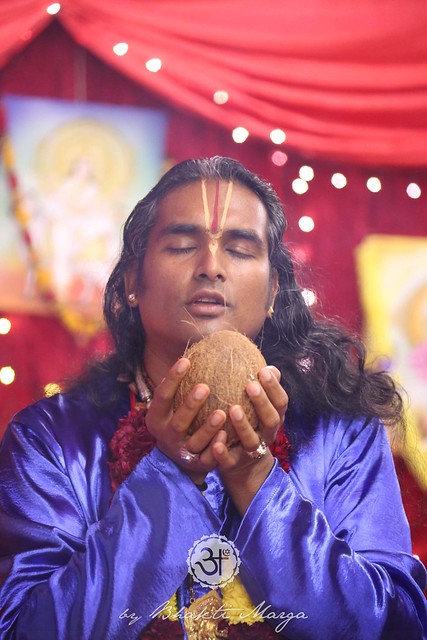 |
| Sri Swami Vishwananda explains the Guru Gita |
On the second night of Navaratri, Sri Swami Vishwananda surprised us all with the following announcement, “Tomorrow I will speak about the Guru Gita, because the nine days of Navaratri are also the nine days of your spiritual path.”
The Guru Gita (Song of the Guru) is part of the Skanda Purana, one of the 18 Puranas compiled by the sage Vyasa.
Sri Swami Vishwananda said, “Normally, there are 400 verses in the Guru Gita, but we will discuss only the main ones, which are 182. The Guru Gita was a discussion between Shankara and Parvati, where Goddess Parvati asked Shiva, ‘Who do you consider the greatest one on earth?’ And Lord Shiva Himself, in the form of Dakshinamurti, explained to Maha Devi saying, ‘The greatest form on earth is the form of the Master.’ And in the Gita Krishna said, ‘It is through My grace that the Guru appears on earth and it is through My grace that the disciples are guided to where they belong.’ So wherever one is, the Guru will search and will attract the disciple. The Guru Gita is one of most wonderful songs, because all that we are doing here, to please the Mother, is also possible only through the Grace of the Master.”

Yesterday night, during the Navaratri celebrations dedicated to Chandraghanta Ma, Sri Swami Vishwananda started his commentary of the first 20 verses of the Guru Gita. Below are some excerpts:
VERSE 1
Sūta uvāca:
Kailāsa-śikhare ramye
bhakti-sandhāna-nāyakam,
Pranamya pārvatī bhaktyā
śankaram paryaprcchata
“Here Shankara Bhagavan is enjoying His devotion for Lord Narayana, because He knows the secret behind that. That's why we can say that He Himself is the embodiment of the sadhana. He was seated on the beautiful Mount Kailash. Parvati bowed to Him with reverence and asked Him... here you have to see that the Mount Kailash stands also for the top most spiritual level. It's not just a place, a mountain, but it stands also for a high level of spirituality. Shankara Bhagavan is there together with Parvati, the two qualities, Shiva-Shakti, the form and the formless. Shiva is considered to be the formless and Shakti the manifested form; both go hand and hand, Purusha and Shakti. But Parvati (Prakriti) which is the manifestation of Shakti, with deep reverence, with humility asked Lord Shiva to explain the deepness which lies on Whom Lord Shiva is meditating and What aspect is That.”
VERSE 3
Kena mārgena bho svāmin
dehī brahmamayo bhavet,
Tvam krpām kuru me svāmin
namāmi caranau tava
“Here Bhagavati is asking about the secret of the Master and by which path a human being will be saved. Bhagavati is very concerned because She knows the creation, She knows that the mind of man is constantly creating karma; each breath, each thought, each action is creating karma. So as a Mother She is concerned about everybody, that's why She is asking the Absolute, ‘How can one attain the Lotus Feet of the Lord? How can one attain the Grace of the Lord?’ So seeing such devotion in Her and Her concern as a Mother for Her children, He said:”
VERSE 4
Īśvara uvāca:
Mamarūpāsi devi tvam
tvat-prītyartham vadāmyaham,
Lokopakārakah praśno
na kenāpi krtah purā
“Shankara Bhagavan said to Parvati, ‘There is no difference between you and Me. Even if we are separated into two forms, yet we are One. You are the very form of Myself, not only in the form, but even in the Self Itself.’ Shiva and Shakti are One. The same as Radha and Krishna are One. So, He said, ‘I will explain this mystery, I will explain what lies behind this secret of devotion, the secret of the Guru; not because you have asked me, but out of the Love that I have for you, I will explain the secret of devotion to you.’ Then He added, ‘No one in this universe has ever asked me this question. You are the first one who asked Me this question and by answering this question to You, through your understanding, all the lokas, the whole universe will benefit from this blessing.’”
VERSE 18
Gurumūrtim smarennityam
gurunāma sadā japet,
Gurorājñām prakurvīta
guror-anyanna bhāvayet
“Here Shankara Bhagavan is saying, ‘Meditate constantly, unceasingly on the form of the Master, with deep devotion and love.’ Not only to meditate, but He also said to chant continuously, to repeat, to do japa with the name of the Master, the Guru. Furthermore He said, ‘Carry out the order of the Guru. Carry out what He says without questioning; carry out what He asks with love and humility. Don't think of anything else than the Master.’”





























